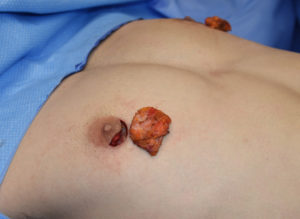Male breast enlargement, known as gynecomastia, presents in various manifestations. While once gynecomastia surgery was most commonly done on teenage boys who developed small (or large) breast mounds that did not recede, today’s gynecomastia reductions are different.
Men are much more particular about the appearance of their chests today and are often intolerant of even the smallest protrusions. A flat chest with a nipple that lays flat is what men seek today. This has led to the most common form of gynecomastia that presents as an isolated areolar protrusion or mound. Known as a puffy nipple, the areolar sticks out from the surrounding skin. In some cases it is just the areola that sticks out and in others the protrusion can be seen to extend beyojd the areolar margins.

The size of the breast tissue that has caused the areolar protrusion its usually very deceiving. The visible elevation of the areolar protrusion seen externally is really just the tip off the iceberg of the total breast tissue mass. Anywhere from a quarter to a fifty cent piece diameter of breast tissue is removed and can be more than a centimeter thick.
Areolar gynecomastia reduction can be done under local, IV sedation or general anesthesia depending upon the patient’s preference. Since it does not involve any excision much behind the areolar margins or liposuction elsewhere on the chest, a drain is not used.
Dr. Barry Eppley
Indianapolis, Indiana


